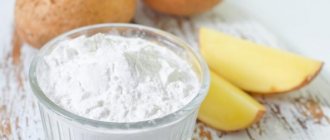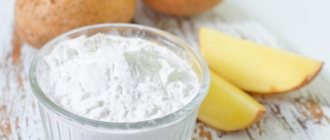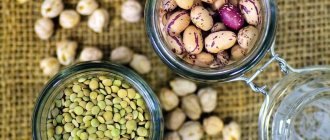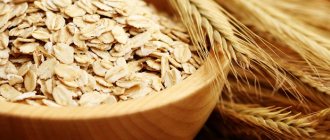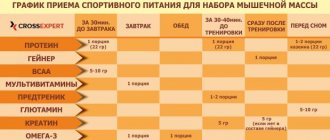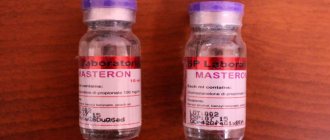Each muscle is made up of cells called muscle fibers (myofibrils). They are called “fibers” because these cells are highly elongated: with a length of several centimeters, their cross-section is only 0.05-0.11 mm. Let's say there are more than 1,000,000 of these fiber cells in the biceps! 10-50 myofibrils are collected in a muscle bundle with a common sheath, to which a common nerve (motoneuron) approaches. At his command, the bundle of fibers contracts or lengthens - these are the muscle movements that we make during training. And in everyday life, of course, too. Each bundle consists of fibers of the same type.
Slow muscle fibers
They are red or oxidizing, in sports terminology they are called “type I”. They are quite thin and well equipped with enzymes that allow them to obtain energy with the help of oxygen (hence the name “oxidative”). Please note that this way, by oxidizing, that is, burning, both fats and carbohydrates are converted into energy. These fibers are called “slow” because they contract by no more than 20% of the maximum, but they can work long and hard.
And “red” - because they contain a lot of myoglobin protein, which in name, functions and color is similar to blood hemoglobin.
What is connected with these muscle fibers. Long-term, uniform movement, endurance, weight loss, cardio and fat-burning workouts, slim, wiry figure.
In motion - life
Remember, like Zhvanetsky: “Maybe big sport is bad. But basic physical training..." Yes, it is necessary, and not only in order to easily catch up with a departing bus or look cool on the beach. Physical activity is the key to active longevity, and this is not a slogan, but an experimentally established fact. They began to prove it, as usual, on rodents. For example, in rats that could run in a wheel for fun, the survival rate, that is, the number of individuals reaching a certain age, was significantly higher than in animals that were deprived of the opportunity to exercise. In mice, exercise improves the functioning of the nervous system, including neuromuscular junctions, reduces hyperglycemia and normalizes cholesterol levels. Physical activity has beneficial effects on the heart, kidneys, brain and liver of various animals. Data from epidemiological studies confirm that it prolongs health and life in humans. In contrast, a sedentary lifestyle often leads to the development of type 2 diabetes, cardiovascular disease, obesity, breast cancer (postmenopausal) and other malignancies, as well as dementia, depression and neurodegenerative diseases such as Alzheimer's disease.
There are several hypotheses explaining the relationship between health and movement. It has been noticed, for example, that physical exercise stimulates the release of adrenaline, cortisol, growth hormone, prolactin and other molecules that regulate the functioning of the immune system. Long-term systematic training reduces the level of stress hormones. In addition, and this is noted by many researchers, physical activity allows you to get rid of the cause of many diseases - chronic systemic sterile inflammation. It is named so because it develops in the absence of infection - as a result of autoimmune processes or other events. Chronic sterile inflammation is a frequent companion to a sedentary lifestyle. This is a very dangerous phenomenon, fraught with the development of insulin resistance, atherosclerosis, neurodegenerative diseases and malignant tumors (see “Chemistry and Life” No. 7, 2013). Inflammatory cytokines are released by overgrown adipose tissue, as well as by the liver and inactive skeletal muscle. Physical exercise can change the situation; it helps even people who started exercising at an advanced age to prevent or stop the development of any ailments. But it's important not to overdo it, because excessive physical activity also provokes inflammation, weakens the immune system and increases the risk of developing infectious diseases. Muscle work and inflammation are related in complex ways, and exercise can either help or harm, depending on amplitude, frequency and other variables. Serious exercise without an instructor is akin to self-medication.
Fast muscle fibers
Either white or glycolytic, they are called “type II”. They are noticeably larger in diameter than the previous ones, they have little myoglobin (that’s why they are “white”), but they have a large supply of carbohydrates and an abundance of so-called glycolytic enzymes - substances with the help of which the muscle extracts energy from carbohydrates without oxygen. This process, glycolysis, (hence the name “glycolytic”) produces a rapid and large release of energy.
These fibers can provide a powerful push, jerk, and sharp blow. Alas, the energy release will not be enough for a long time, so fast fibers do not work for long, they need to rest often. Strength training designed for them is therefore divided into several approaches: if you move continuously, the work is transferred to the slow fibers.
What is connected with these muscle fibers. Strength training, sprints, acceleration, muscular, pumped up figure, figure modeling, voluminous muscles.
Neurotrophic factors
These proteins, as the name suggests, are synthesized in nerve cells and regulate their development and activity. For example, the brain-derived neurotrophic factor BDNF affects learning and memory, and its deficiency is associated with obesity and type 2 diabetes. However, after exercise, BDNF levels in the blood increase significantly, with 70–80% of this amount consumed by the brain. In skeletal muscle, BDNF enhances fat oxidation and regulates cell regeneration.
Another protein, ciliary neurotrophic factor CNTF, is responsible for the work of osteoblasts, the cells that build bone tissue. Mice deficient in this gene have massive and poorly mineralized bones. Citizens who lead a sedentary lifestyle and lack CNTF often develop osteoporosis (a metabolic disorder of bone tissue that leads to their fragility). With muscle calcification and periosteum overgrowth, on the contrary, physical activity is harmful because increased CNTF synthesis will only worsen these symptoms.
Two types of fast muscle fibers
Yes, yes, not everything is so simple! Fast-twitch muscle fibers are also divided into two “divisions.”
Fast oxidative-glycolytic or intermediate fibers (subtype IIa) are fast (white) fibers, which nevertheless contain the same enzymes as slow ones. In other words, they can obtain energy both with and without oxygen. They are reduced by 25-40% of the maximum, and are “involved” in both strength training and weight loss exercises.
Fast non-oxidizing fibers (subtype IIb) are designed exclusively for short-term and very powerful efforts. They are thicker than all others and during strength training they increase more noticeably in cross-section than others, and contract by 40-100%. It is due to them that bodybuilders increase muscle volume, weightlifters and sprinters set records. But for fat-burning training they are useless. It is important that about 10% of muscle fibers (those fast intermediate ones - subtype IIa) can change their type.
If you often give your body a long-term load of moderate intensity (one that includes a maximum of slow-twitch fibers), then the intermediate ones will also adjust to the slow mode in a few months. If you focus on strength and sprint training, then both intermediate and even red fibers will approach fast fibers in their parameters.
Muscle and PGC-1α
The movement of the human body is provided by about 600 skeletal muscles, which make up approximately 40–50% of body weight. They consist of myofibrils formed by fused myoblast cells, and myofibrils are made of actin and myosin filaments organized into repeating blocks called sarcomeres. The movement of these threads relative to each other causes muscle contraction. Unlike smooth and cardiac muscles, skeletal muscles contract voluntarily in response to a signal from the neurotransmitter acetylcholine.
Work requires energy. During dynamic contractions that require endurance (long running, swimming), and when maintaining a posture, energy is provided by ATP, obtained through oxidative phosphorylation occurring in mitochondria. Glucose and glycogen are the first to be oxidized. During movements that require great strength and speed (sprinting, weight lifting), muscle fibers break down glycogen anaerobically through the process of glycolysis. In this case, ATP is formed two to three times faster, and the mechanical energy produced by the muscle is two to three times greater than during oxidative phosphorylation. But fatigue also sets in much faster in this case.
Depending on the type of work performed, muscle fibers synthesize different transcription regulators, growth factors and other molecules that allow them to adapt to a particular type of load. Strength training leads to the preferential development of so-called fast fibers, which use glycolysis to synthesize ATP. With appropriate loads, their number and cross-sectional area increase. Fibers that perform dynamic work are called slow. They need many mitochondria, a developed capillary network to supply oxygen, and counteract protein degradation, apoptosis and inflammation. A significant role in meeting these needs is played by the transcriptional regulator PGC-1α (peroxisome proliferator receptor coactivator), which is synthesized during the contraction of slow fibers. Let's remember this protein, it is one of the main characters of our story. Perhaps its role in myofibrils is no less than that of actin and myosin. In mice, it regulates the expression of more than one and a half thousand genes: it suppresses the activity of some, stimulates others; how many in humans has not yet been calculated. PGC-1α has many functions, including promoting mitochondrial formation, fatty acid oxidation, and resistance to muscle wasting. Transgenic mice with excess PGC-1α are pumped up and muscular, while animals with an inactive gene have very poor endurance. During exercise, cellular factors are released that modify the PGC-1α protein, making it more stable and therefore active. At the end of the workout, PGC-1α levels return to normal within an hour.
During long-term, systematic endurance training, the proportion of slow fibers increases at the expense of fast ones, and PGC-1α again plays a significant role in these transformations (Fig. 1). In trained muscles, the level of PGC-1α is higher than in untrained muscles, even at rest, and since it regulates the metabolism and function of many genes in myofibrils, exercise may be useful in some diseases associated with impaired muscle activity. Studies in mice have confirmed that PGC-1α does mitigate the effects of Duchenne myopathy and mitochondrial myopathy (muscle wasting due to mitochondrial dysfunction).
Rice. 1.
Role of PGC-1α in endurance-trained muscle fibers
PGC-1α also suppresses the activity of the NFκB factor, the main regulator of proinflammatory gene expression. Consequently, a sedentary lifestyle provokes the synthesis of pro-inflammatory cytokines and the development of local and systemic inflammation, the unfortunate consequences of which we have already discussed.
We have all heard that a healthy mind resides in a healthy body. And this is true, because PGC-1α also protects against depression. This disease affects the lives of millions of people around the world. Depression is associated with the formation of kynurenine, a product of tryptophan degradation, under the influence of stress and inflammation. Kynurenine synthesis occurs mainly in the kidneys, liver and cells of the immune system, but from there the substance enters the blood and brain. Kynurenine causes neuronal death and inflammation of nervous tissue, leading to depression. Experts from Karolinska University (Sweden), experimenting with mice, discovered that PGC-1α enhances the synthesis of the enzyme kynurenine aminotransferase in skeletal muscles ( Cell
, 2014, 159, 33–45, doi: 10.1016/j.cell.2014.07.051). This enzyme also enters the blood and converts kynurenine into kynurenic acid, which cannot cross the blood-brain barrier. Plasma kynurenine levels are reduced, which protects the brain from damage and stress-induced depression. Researchers don't rule out that PGC-1α could be used for therapeutic purposes, but wouldn't it be more beneficial to exercise?
So, physical activity, mainly endurance training, increases the level and activity of PGC-1α, which has a beneficial effect on many vital processes or protects us from health problems. In addition, muscle contractions and PGC-1α activate the synthesis of proteins that affect processes occurring both in muscle tissue and in other organs, so skeletal muscle can rightfully be considered an internal secretion organ (Fig. 2). These regulatory proteins are called myokines. The list of myokines is constantly growing, and it often includes compounds that are already known to us in another capacity, for example, interleukins, a product of the synthesis of leukocytes and essential participants in the immune response.
Rice.
2. Muscle tissue - an organ of internal secretion
Muscle fibers: how to determine your type
Typically, a person has approximately 40% slow fibers and 60% fast fibers. Their exact number is determined genetically. Analyze your physique and perception of stress. As a rule, people who are naturally “wiry”, short in stature, with thin bones, who can easily walk, jog, ride a bike and other long-term activities, have a slightly higher percentage of slow and intermediate fibers.
And those who have wide bones, muscles easily grow even from small loads, but also the fat layer is added literally from one glance at cakes or pasta, are often “carriers” of some excess of fast-twitch fibers. If you know a person who, without really training, suddenly amazes everyone with his strength, you have a large number of fast, non-oxidative fibers. You can find tests online that offer to determine your predominant muscle fiber type. For example, doing an exercise with a weight of 80% of the maximum. If you completed less than 8 repetitions, your fast-twitch fibers predominate. More - slow.
In fact, this test is very conditional and speaks more about training in this particular exercise.
[new-page]
Growth factors
Vascular endothelial growth factor VEGF actually regulates endothelial growth and stimulates angiogenesis. Its synthesis in muscle fibers is under the control of PGC-1α and is coordinated with the synthesis of another myokine, SPP1. This protein stimulates the activity of macrophages, endothelial cells and smooth muscles, which also contributes to the formation of capillaries. (For information on how the synthesis of VEGF helps with ischemia of the lower extremities, see the article “Genes against amputation,” “Chemistry and Life” No. 7, 2016.)
Fibroblast growth factors regulate cell division, growth and differentiation and cellular metabolism. One of them, FGF21, is synthesized primarily in the liver, but also in adipose tissue, pancreas and skeletal muscle. Depending on the site of synthesis, FGF21 performs different functions. Hepatic stimulates the expression of PGC-1α, which in turn activates fatty acid oxidation and glucose synthesis in the liver. In adipose tissue, FGF21 increases glucose uptake, and in transgenic mice, excess FGF21 protects against the development of obesity. This protein reduces blood sugar and triglyceride levels in diabetic rodents, meaning it could theoretically be a cure.
The synthesis of FGF21 in skeletal muscles does not depend on muscle load, but on excess insulin or low temperature. In the first case, FGF21 regulates insulin levels, in the second it stimulates thermogenesis in brown fat cells.
Muscle Fibers: Exercise Selection
The names “fast” and “slow,” as you already understood, are not related to the absolute speed of your movements in training, but to the combination of speed and power. In this case, of course, muscle fibers are not involved in work in isolation: the main load falls on one type or another, and the other acts “in support”.
Remember: if you work with weights, the higher they are, the more actively the fast-twitch fibers are trained. If the weights are small, movements to train fast fibers should be sharper and more frequent. For example, jumping instead of squats, a 100-meter sprint instead of a leisurely cross-country, etc. But to train slow fibers, you need long, quiet workouts such as steady skating, walking, swimming, and calm dancing. Any acceleration and jerk will additionally connect fast fibers.
Interleukins
There are currently three interleukins on the list of myokines: IL-6, IL-8 and IL-15. IL-6 and IL-15 are known to be inflammatory factors; in addition, IL-6 causes insulin resistance and also, under certain conditions, increases the level of anti-inflammatory cytokines. IL-8 is responsible for neutrophil recruitment and angiogenesis. In muscle cells they have different tasks. All three proteins are typical myokines, their synthesis in skeletal muscle and concentration in the blood plasma increase after exercise, and IL-8 is mainly affected by exercise in which the loaded muscle is lengthened.
IL-6 acts on different tissues. It triggers cascades of biochemical reactions, as a result of which muscle cells consume more glucose and actively oxidize fatty acids, lipolysis increases in adipose tissue, glycogen breakdown and glucose formation in the liver, and insulin secretion in the pancreas. The production of glucose in the liver and the release of fatty acids from adipose tissue provide energy to working muscles.
The role of IL-8 in skeletal muscle is still unknown, but there is reason to believe that this factor stimulates the growth of new blood vessels.
IL-15 is originally known as a muscle anabolic; it also induces the synthesis of contractile proteins, promotes glucose uptake and fatty acid oxidation, and counteracts cancer cachexia (wasting) in rats. The higher the plasma concentration of this myokine in humans, the less white fat they have, and in rats it increases thermogenesis.
Muscle fibers: planning training
* If you need to add volume to a particular part of the body (say, pump up your arms, shoulders or hips), train mainly fast-twitch fibers in these areas by lifting weights and doing jumping jacks, push-ups, and pull-ups.
* If you want to get rid of excess fat, “load” slow fibers throughout your body. The best options for this are walking with poles, running, swimming or dancing.
* To further work on problem areas, add exercises on slow fibers: abduction-adduction of the leg, flexion, etc.
*For overall muscle tone, train both fiber types equally. Let's say, in the mode of a half-hour strength lesson and a half-hour cardio load after it 3-4 times a week.
By understanding what fast-twitch and slow-twitch muscle fibers are, you can tailor your workouts more effectively.
Two against cancer
An active lifestyle not only reduces the risk of developing metabolic disorders, but may also protect against certain types of cancer. Thus, according to the World Cancer Research Fund, physical exercise reduces the likelihood of developing breast and colon cancer by 25–30%. Scientists explain this influence in different ways. In particular, two recently discovered myokines, SPARC and OSM, suppress the division of cancer cells in the colon and breast and induce their apoptosis. What role these proteins play in a healthy body is not yet clear. It is possible that they regulate cell division and apoptosis in contracting muscle fibers, but it is possible that the effect of SPARC and OSM on non-cancerous cells is not associated with their division and death at all.
The list of myokines is long and may bore the reader. However, it would be incomplete without myostatin, which can be called an antimyokine: muscle contractions do not stimulate, but suppress its synthesis.
Alternating ranges for maximum weight
If you want to gain as much muscle as possible, then vary the number of repetitions. Don't limit yourself to just the "bodybuilding" range (6-12 reps), but also use high-rep (15-20 or more) and low-rep (1-5) protocols.
This variety will not only lead to full stimulation of muscle fibers of all types, but will also help in other aspects. Low-rep sets will improve neuromuscular adaptations, developing maximal strength and allowing you to lift more weight for moderate reps. High-rep sets will push back your lactate threshold, increasing endurance and increasing time under tension in the midrange.
Use linear or non-linear periodization to vary the number of repetitions and ensure constant progress. Both models work great, the choice depends on personal preferences and goals (i.e. the need to peak at a certain point in time).
Another option is to tie ranges to exercise types. For example, in multi-joint exercises, work in a low and medium number of repetitions (~1-10), and leave multi-repetition exercises (15+) for isolating movements, in which it is better to use small weights.
There is no one general rule; the response to training stimuli varies individually. So experiment and find a scheme that works best for you.
Name of human muscles
When anatomists in the Middle Ages began to dig up corpses on dark nights to study the structure of the human body, the question arose about the names of the muscles. After all, it was necessary to explain to the onlookers who had gathered in the anatomical theater what the scientist was currently cutting with a sharply sharpened knife.
Scientists have decided to name them either by the bones to which they are attached (for example, the sternocleidomastoid muscle), or by their appearance (for example, the latissimus dorsi or trapezius), or by the function they perform (extensor digitorum longus). Some muscles have historical names. For example, tailoring
so named because it drove the sewing machine pedal. By the way, this muscle is the longest in the human body.
What else should I read?
How are birds counted?
Cell theory in biology
What is photosynthesis? The history of the discovery of the process, the phases of photosynthesis and its significance.
Mathematics bees
Training[edit | edit code]
Author: Kirill Agoghe
In RuNet there is a system of views on the growth of slow fibers (hereinafter referred to as SMV, they are also type I):
- They don't grow from heavy weights
- They do not grow from working at full amplitude, since a special amplitude is needed for their growth, work without muscle relaxation
- Slow fibers require slow movements
- It is not possible to change fiber type from II to I
- A separate topic is the use of pharmacology for their growth and increase in endurance
- Low-intensity work (at ANP and below ANP) recruits only slow fibers, and sprints and extreme accelerations recruit all fibers
Read
: statodynamics and statodynamic exercises for training OMV according to Seluyanov.
Slow fibers do not grow from heavy weights[edit | edit code]
Slow fibers hypertrophy from working with both light, heavy and medium weights.[2] Moreover, cases were found when, over the course of one year, observing the reaction of older people to training, they had nothing but growth in slow fibers from working with 75% of 1RM, and only by the end of the year, growth in fast fibers was added to the growth of slow fibers. [3] Studies of protein synthesis, amino acid consumption, and satellite cell activation also show that slow fibers respond just like fast fibers to work at 70-80% of 1RM.[4][5][6]
There is also the fact that myosin chains and fiber types change in contraction speed from training, as well as from lack of training due to injuries and physical inactivity. Moreover, it is working with heavy weights that reduces the level of myosin IIX.[7]
By lifting light weights, you do not increase the growth of slow fibers, but rather reduce the efficiency of growth of fast fibers. But they still activate and grow even with light weights, especially in triple sets one after the other. In addition to the fact that large weights lead to the growth of slow fibers, they also lead to the growth of nuclei in cells.[8]
Also, working with heavy weights in weightlifters not only leads to a change in the speed of muscle contraction, but also causes the growth of mitochondria.[9] But this occurs without an increase in MIC, which indicates the insufficiency of mitochondrial growth and a change in fiber type alone. And he emphasizes that you need a transport system for oxygen that doesn't just happen because you have slow fibers and mitochondria.
Slow fibers do not grow from working at full amplitude[edit | edit code]
We already know that slow fibers hypertrophy from any weights at any amplitude. When you work with light weights without relaxing your muscles, you are still training all your muscles, they just do not turn on immediately if the weight is light, but gradually.[10] Only as the approach, or series of approaches, continues, more and more fast-twitch type II fibers are brought into play. By taking 50% of your 1RM without relaxing the muscles, you can say that you are training all your fibers at once. The benefit of pumping is not so much in the growth of slow fibers, but in a host of other positive effects, for example, angiogenesis (capillarization)[11], arteriogenesis (stimulation of collaterals[12], improved blood supply to muscles). Potentially, muscle ischemia can also stimulate erythropoiesis, an increase in blood volume. Those. Pumping is a useful tool for the development of transport systems and for increasing endurance. And this, among other useful tools, is mentioned in reviews.[13][14][15][16][17][18][19]
It is not possible to change fiber type from II to I[edit | edit code]
Indeed, muscle composition is genetics. But the genetics of the motor neuron, if you do not use it, for example, due to a sedentary lifestyle or injury, leads to the fact that the slow fibers become fast, and after returning to training, they become slow again. Muscle composition[20] can also be influenced by electrical stimulation[21] and the state of the thyroid gland. If, due to mutations, your conversion of fast fibers to slow fibers is impaired[22], then the growth of capillaries and mitochondria will be useless.[23]
Taking pharmacology to grow slow fibers and increase endurance[edit | edit code]
If muscles do not grow, then often their growth begins to be stimulated by taking a course of testosterone. BUT! In slow fibers, there is no receptor response to changes in testosterone levels. They respond to growth hormone, IGF-1, insulin[24]. This does not mean that you need to take them to become stronger. Taking testosterone[25], as well as GH, disrupts the functioning of mitochondria, and the subsequent depletion of testosterone[26] after stopping the course additionally affects the mitochondria. Just having healthy natural hormone levels is enough for mitochondrial health.[27][28][29] Thyroid health is equally important for mitochondrial health.[30] For example, women have muscle hypertrophy from estrogen, and it is through estrogen receptors that ecdysterone “works.”[31][32]
Low intensity work recruits slow fibers[edit | edit code]
In a number of studies, there are claims that at low intensity of work, fat and glycogen are spent only in slow fibers, and at maximum intensity - in all fibers. But what is the secret to progress from high-volume, low-intensity training? The fact is that as glycogen is depleted, more and more new fibers are included in the work[33][34][35][36], and if a beginner needs 30-60 minutes[37] to work out all his muscles, then a professional athlete (in endurance sports), to deplete glycogen you will either have to do a lot of sprints[38] or do a longer volume workout. It is not for nothing that a correlation is found between PGC-1 activity and the degree of glycogen depletion[39]. Sprints do not stimulate the growth of blood volume and hemoglobin mass [40], but volume training does [41].
It is also important to choose the optimal rest and sprint time to get the effect of training, and individually.[42] Elite athletes in the CVS do high volumes of training, and knowing that they recruit 100% of the muscle fibers makes it clear why they get results from them.[43] For untrained active people, intervals had no advantage over volume training.[44]
Slow fibers require slow movements[edit | edit code]
The difference in contraction speed between the 2 types of muscle fibers does not make any difference when strength training with a barbell. You can learn to turn on fast contractions without slow ones, but this will have zero practical meaning in bodybuilding[45], since the only meaning in the speed of contraction is that fast fibers during sudden movements can be recruited before slow ones, slow ones can be switched off earlier[46] . That is, jerky movements with small weights work not slow, but fast fibers, but this is unimportant within the framework of the fact that work without muscle relaxation will still include fast fibers. Also, the fact that fast fibers are recruited before slow ones during fast movements may explain to us why people with a large proportion of MMV jump low, and those with a large proportion of fast fibers jump high [47][48].

